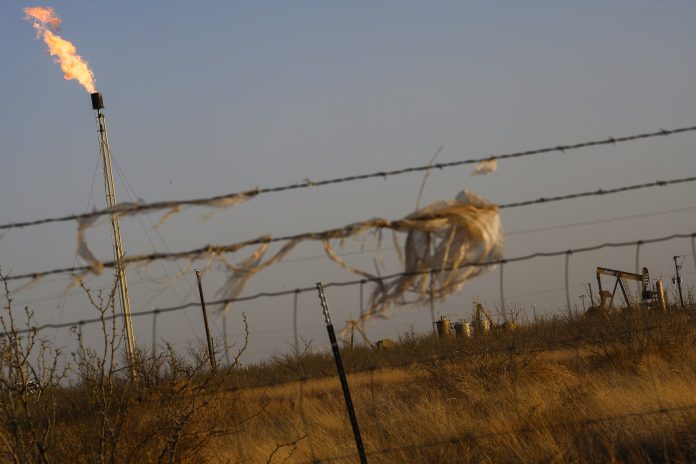
The natural gas market has been woeful for over a year and it will stay that way for a while longer with an oversupply stemming from hostile federal policies and inadequate pipelines.
Yet the burgeoning need for more electricity and the perfection of natural gas as the source of it make energy experts optimistic.
Odessa oilman Kirk Edwards and the Permian Basin Petroleum and Texas Independent Producers & Royalty Owners associations say President Biden made a tough situation worse with his January prohibition of new liquefied natural gas export terminals.
“I think the future for natural gas is amazingly bright, but it has storm clouds in the near future,” Edwards said. “Today we have such a glut in West Texas because the pipeline systems simply can’t get all of the gas out of here and to the markets that can use it.
“That and the compounding of the Biden administration’s moratorium on building out new LNG facilities to allow natural gas to be exported makes for a very uncertain market in the near term. But any kind of hurricane season in the Texas Gulf and a hotter than normal summer coupled with a very cold winter could see the gas surpluses go away.”
Edwards said those factors and the expected resurgence of the electricity sector from the very demanding new artificial intelligence data centers and the retirement of coal and aging nuclear facilities could create a perfect storm for higher prices.
“The futures markets indicate better pricing ahead and just this past month prices are up some 60 percent alone from very poor levels in the $1-$2 range,” he said. “To me I would rather be betting on gas prices going higher long term than lower from here.”
The average Henry Hub price in 2023 of $2.57 per thousand cubic feet was the lowest since the doldrums of the pandemic in mid-2020. Standing at $2.807 Wednesday, the price had been $4.38 in January and $8.14 in May 2022 and $3.27 in January and $2.15 in May last year.
PBPA President Ben Shepperd said international supply and demand have a great impact.
“Any increase in that demand whether from local use or use anywhere in the market will affect prices in the Permian Basin,” Shepperd said. “Outside of this major factor, however, takeaway constraints can have an impact on how natural gas, specifically that produced in the Basin, is discounted or sold at a premium compared to gas produced from other regions.”
Currently, Shepperd said, there are constraints because of a series of outages at LNG terminals on the Gulf Coast earlier this month and scheduled maintenance on some takeaway pipelines in the Basin.
“Prices shouldn’t be as depressed once these constraints are alleviated, but we will still likely need increased takeaway capacity to keep pace with growing production,” he said. “The Matterhorn Pipeline, a project operated by White Water, is scheduled to come online in the third quarter, which will be helpful.”
TIPRO President Ed Longanecker said Texas is well positioned to capitalize on the boom in data centers and the sought-after power needed to operate them.
“Roughly 25 percent of the country’s natural gas reserves are located in Texas,” Longanecker said from Austin. “Those reserves combined with our extensive infrastructure, business-friendly government and technical workforce have several large tech companies considering Texas the premier place to grow their businesses.”
He said there are many questions concerning the Electric Reliability Council of Texas’ ability to handle all this new demand on a system that has proved shaky during power shortfall months.
“There are even higher-level questions and concerns over the safety and utilization of AI if it becomes prioritized over our base-level electrical needs,” Longanecker said. “Natural gas is the only reasonable answer and we are encouraged that there is yet another near-term need for our gas alongside LNG exports.
“Abundant, reliable, cost-effective and clean natural gas continues to be a superior fuel source for our rapidly changing society.”
According to the U.S. Energy Information Administration, he said, approximately 2,710.7 miles of natural gas pipelines are expected to come into service this year with the capacity to transport up to 36,797 million cubic feet of gas per day.
“An additional 1,994 miles carrying up to 21,706 MMcf per day are expected to come online in 2025,” Longanecker said. “Electricity demand in Texas is significantly increasing, much more so than in the rest of country.
“The rise of artificial intelligence, data centers and crypto mining are driving much of this demand growth. ERCOT estimates its load could reach 152 gigawatts, almost double its historic peak, with industrial electricity demand increasing by 37 percent.”
He said Texas is home to more than 240 data centers, particularly in the Dallas-Fort Worth area, which saw a 173.1-percent increase in the second half of 2023 alone.
“The power grid’s minute-by-minute variations are especially critical in the summer and winter months when energy usage spikes,” Longanecker said. “To power through these demand peaks and ensure that the grid remains operational, dispatchable, reliable power like natural gas is critical.
“Natural gas was necessary to fill the drop in solar generation that was experienced during the solar eclipse in April that saw as much as 100-percent totality in parts of the country, including Texas. The state experienced a significant drop in utility-scale solar electric generation, according to the EIA.”



